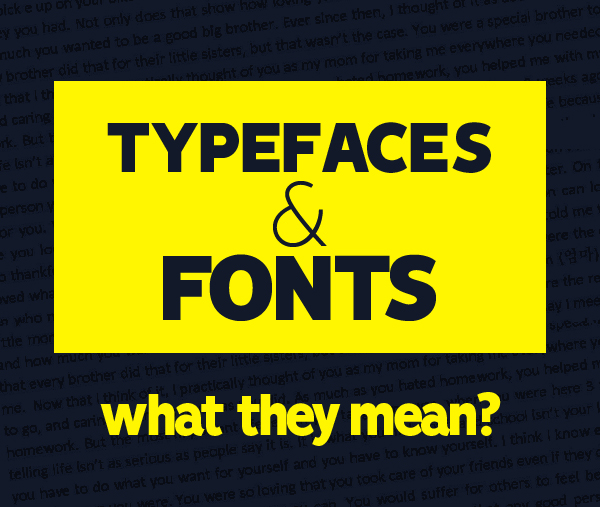

Put simply, a typeface is a family of related fonts, while fonts refer to the weights, widths, and styles that constitute a typeface. If you were a doctor and you met a contemporary who confused a tibia and fibula, you'd probably think a little less of him. A typeface is a design style which comprises a myriad of characters of varying sizes and weight, whereas a font is a graphical representation of text character. If your boss asks you to "change the font on the slideshow," it probably won't do you any favors to correct her and say "I can't change the font, but I can change the typeface." It also doesn't help things that at least some programs get the terminology wrong, or don't specify that they use a "typeface" instead of a font in the user interface.īut if you're a designer of any capacity, and you're speaking with other designers, it's best to get the terms right. And to be perfectly honest, that's not such a terrible thing-it's a very small distinction now that type design is so malleable in terms of design and publishing. It has to be integrated into existing business processes, existing cultures and organizations,” Parasnis says.Even among professionals, the terms "font" and "typeface" are often used interchangeably. “As exciting as generative AI is, it can't be on its own island. Getting a typeface confused with a font is something a lot of peopleeven sometimes designersroutinely do.

With the new funding, Typeface plans to scale its team and develop new products to automate other business functions like customer service. What is a Typeface and How Is it Different from a Font If you’ve ever had to ask what is a typeface, you’re not alone. For now, Parasnis says customers will be in control of their data and decide which AI models they want to work with. That’s one of the reasons why content created through Typace’s platform contains metadata that labels the content as made by AI. You can think of typeface as another term for font (the two words are often used interchangeably), although it's more accurate to call a typeface a. When you choose a typeface for your resume, you'll want something that's businesslike and easy to read. fonts again: here’s how they’re different Never be confused by the typographic terms again: we break down the difference with this explainer. A typeface is a specific design of letters and numbers, either in print or on a computer. So brands can reduce their risk, especially if they tell customers that this was AI generated,” Gualtieri says. DESIGN Never be confused by typefaces vs. “One of the good things about the widespread experimentation of these AI tools by consumers is that now… there's some expectation that it's not perfect. Display fonts are largely meant for that purpose alone, meaning they can work wonderfully as part of headlines or logo designs but rarely as standard text intended for longer. Even though Typeface incorporates safety filters like plagiarism and authenticity checkers, the models may create content similar to an existing trademarked logo, he says. The first sans serif typeface appeared in print in 1816, but serifs still remained widely popular throughout the late 19th century and into the early 20th century. However, because Typeface’s tools are built on models like Stability AI’s Stable Diffusion 2.0 and OpenAI’s GPT-4 that are trained on public data, they run the risk of creating content that could infringe copyrights or IP laws, says Gualtieri. This kind of AI-generated personalized marketing content could be an effective and cheap way to target customers and test content strategies, says Mike Gualtieri, a principal analyst at Forrester who researches AI for global enterprises. Parasnis says companies are using tools like Typeface to create a “content factory” to produce 10 times the amount of content they previously generated to share across social media.


Users can also use AI to convert existing video content like a conference recording or a keynote speech into an email or a blog post. This is a semi-serif kind of typeface, meaning it lies somewhere in between the traditional serif letters and the modern sans-serifs. But the calligraphic side of this typeface demonstrates the designer’s willingness to experiment, as well as his creativity.
#TYPEFACE MEANING PROFESSIONAL#
Since it publicly launched in February, Typeface has released Image Studio, a feature that lets users use textual prompts to create or edit product photos without needing a professional photoshoot or studio. Typography can be defined as the art and technique of creating or arranging written words in a way that it is readable, legible, and appealing when displayed, or when printed as an artwork 6. Le Murmure is mostly a title font, with elongated, solid, sophisticated letters.


 0 kommentar(er)
0 kommentar(er)
